Final Report for GNE14-083
Project Information
Anaerobically digested dairy fiber (ADDF), a byproduct of methane production from dairy manure, shows promise as a locally sourced alternative to peat for growers in the Northeast. ADDF has been shown to be a viable alternative to peat in a variety of greenhouse crop trials but there is currently no information published on using ADDF as a component of SPM for nursery crops. Using ADDF in nursery media has the potential to benefit growers (by providing a locally sourced, inexpensive, sustainable alternative to peat), dairy farmers (by turning ADDF into a valuable horticultural product and providing a lucrative waste management solution) and the environment (by incentivizing dairy farmers to adopt anaerobic digesters and recycling nutrients in manure into horticultural crops)
Long and short term plant growth trials were conducted to evaluate the performance of a variety of woody and herbacious nursery crops in different stages of production grown in ADDF- or peat-containing media. Various parameters, such as plant size, stem caliper and number of shoots were measured regularly to evaluate plant growth over time. Leaf tissue samples were analyzed for nutrient concentration to estimate nutrient uptake. Water holding capacity, bulk density and shrinkage were measured throughout trials compare the durability of the mixes over time. Aqueous extracts were used to regularly to monitor pH, EC and nutrient status of potting media in situ.
Plants grown in the ADDF-containing mixes grew to be of equal or better size and quality to those grown in the peat-containing mixes. Both mixes had similar changes to physical proporties over time. Both mixes underwent the same amount of shrinkage during two growing seasons but the ADDF mix experienced more shrinkage under overhead irrigation than the peat mix. Significant amounts of phosphate and nitrate leach from ADDF mixes. Nitrate and phosphate from ADDF could contribute to plant nutrition but could also be a an environmental issue.
This project began during the summer of 2014 and concluded in December 2015. This study was conducted in the greenhouses, research fields and laboratories located at the University of Connecticut.
Introduction:
The purpose of this project is to evaluate anaerobically digested dairy fiber (ADDF) as a sustainable alternative to peat in nursery container mixes. Peat is plant material, usually Sphagnum moss, which has been partially decomposed under low-nutrient, acidic, anaerobic conditions in bogs, leaving only a lignified cell wall structure. Peat has physical and chemical characteristics which are well suited to use in growing mixes (Handreck, 1994). Recently, concerns about the sustainability of peat have been raised. Peatlands are wetland ecosystems that are both economically and ecologically important. Peat mining harvest from deep in the bogs and can represent hundreds of years of peat accumulation. This drastically alters the chemical, physical and biological composition of peatlands. Even after mined peatlands have been “restored” it takes several years to restore their ecological functionality. Most peat is produced in cold, northern regions and must be shipped long distances to more temperate horticultural areas. These concerns have prompted a search for sustainable, local alternatives to peat (Chalker-Scott, viewed May 5, 2014).
One of these potential alternatives is ADDF; a byproduct of methane extraction from dairy manure. Systems to extract methane and reduce odor from manure have been used since the 1970’s and have seen vast improvements in the ensuing decades. Selling methane as a biofuel generates additional income or on-site energy for livestock farmers and utilizes this carbon-rich greenhouse gas rather than losing it to the atmosphere and contributing to climate change. Some dairy operations generate more revenue from selling methane as a biofuel than from traditional dairy products (Miller, 1999).
Marketing ADDF as a useful horticultural material rather than simply manure could become yet another source of income for dairy farmers and provide a solution to same waste management problems associated with raw manure. Leaching of nutrients from accumulated manure is significant source of non-point source water pollution. If ADDF were used in a growing media, nutrients that would otherwise be lost as pollutants could be used for plant nutrition.
The potential for use of ADDF in growing media is especially promising for the Northeast region. Agriculture in the Northeast is characterized by small diversified enterprises occupying a large portion of the industry. The diversity of farms and strong local agricultural networks in the Northeast make it an ideal locale for a product like ADDF potting mixes to be used widely.
Mixes containing ADDF have been used successfully to grow bedding plants (MacConnell and Collins, 2007; Lamont, 2015), vegetable seedlings, garden mums and poinsettias (Lamont, 2015). In previous trials at UConn several species of bedding plants, as well as cyclamen grown in ADDF mixes had varying results, likely due to specific crop responses to pH and high salts.
Currently, there is no information published about growing woody or herbaceous perennials in ADDF mixes. The robust nature of woody perennials suggests they could be excellent subjects to grow in ADDF. Nursery crops are usually grown in containers with larger volumes than floriculture crops so the nursery industry has the potential to use large amounts of ADDF as a media component. The longer growing season of nursery crops presents a need to further investigate the physical and chemical stability of ADDF over time.
The greenhouse, nursery and dairy industries are important to the New England economy and generate about one third of all agricultural cash receipts in New England (New England Agricultural Statistics, 2012). The environmental horticulture industry of New England represents almost 5 billion dollars, 11,900 firms, and 156,000 jobs and is growing. Nursery production represents a significant portion of this industry with almost half of New England horticultural firms engaged in some kind of production enterprise (New England Nursery Association, 2009). ADDF shows promise as a locally sourced, inexpensive, sustainable alternative to peat for growers in the Northeast
Utilization of ADDF in SPM could greatly benefit the Northeastern dairy industry as well. The dairy industry of New England has historically been, and continues to be a vitally important part of the region’s economy. Despite contributing over 3 billion dollars to the region’s economy annually, the New England dairy industry has been in long term decline (Department of Economic and Community Development and Department of Agriculture. 2009).
Methane extraction from manure shows great promise as a supplementary revenue source for Northeastern Dairy farmers but revenue generated by energy production alone is often not enough to offset the capital costs of constructing anaerobic digesters. If ADDF were proven as a high quality media component, it could be a value-added product to add to dairy profits. The demand for ADDF from growers would be an added incentive for dairy farmers to adopt the more sustainable anaerobic manure digestion systems (Lynda Brushett Cooperative Development Institute, Barrington, New Hampshire, personal communication, May 1, 2014).
References
Chalker-Scott, L. “The myth of permanent peatlands”. Extension Urban Horticulture, Washington State University. Viewed May 5th, 2014. <http://puyallup.wsu.edu/~linda%20chalker-scott/Horticultural%20Myths_files/Myths/Horticultural%20%20peat.pdf>
Department of Economic and Community Development and Department of Agriculture. 2009. The economic and fiscal impacts of Connecticut’s dairy industry.
Handreck, K.A. and N.D. Black. 1994. Growing media for ornamental plants and turf. Revised edition. University of New South Wales Press, Randwick, New South Wales, Australia.
Lamont J.R. 2015. Evaluating anaerobically digested dairy fiber as a substitute for peat in container production and nutrient availability from organic fertilizers and amendments. Master's Theses, University of Connecticut
MacConnell, C.B. and H.P. Collins. 2007. Utilization of re-processed anaerobically digested fiber from dairy manure as a container media substrate. Proc. IS on Growing Media.
Miller, P. 1999. Methane recovery from manure: control odor and produce energy. Iowa Manure Matters: Odor and Nutrient Management.
New England Agricultural Statistics. 2012. New England cash receipts 2011.
New England Nursery Asscociation. 2009. A summary of the impact of the environmental horticulture industry on the New England economy.
- To evaluate ADDF as a substitute peat in soilless potting media mixes.
- To evaluate nutrient availability in ADDF over time.
- To evaluate physical changes to ADDF over time.
Cooperators
Research
Woody Nursery Crops. Liners of button bush (Cephalanthus occidentalis) and silky dogwood (Cornus amomum) were transplanted into #2 pots (7.3L volume) containing either the 4:2:1 bark-ADDF-sand amended with 4g/L gypsum or 4:2:1 bark-peat-sand amended with 2.5g/L dolomitic lime. Plants were fertilized with a top dressing of Osmocote 18-6-12 (Everris NA, Inc.) at a rate of 30g per pot. Plants were grown outdoors with natural season lighting and irrigated with drip irrigation during the first season’s growth. Plants were overwintered in an unheated hoop house. Plants were moved from the hoop house and forced out of dormancy in a double polyethylene film greenhouse with overhead irrigation. At the end of the first growing season, plant height, width, thickest stem caliper and number of shoots were measured. After leafing out at the beginning of the second season (approximately 10 weeks after being moved into greenhouse) plant height and shoot fresh weight and dry weight were measured. Leaf tissue samples were taken for nutrient analysis at the end of the first season before plants began to enter dormancy and at the beginning of the second season after plants had leafed out. SME samples were taken from media before planting to measure pH and electrical conductivity (EC) using Twin pH/conductivity meters (Horiba Corp., Kyoto, Japan). PourThru samples were taken regularly and analyzed for pH, EC and nutrient concentrations during the first season.
The physical properties of This mixes used in this trial were evaluated using the techniques described by Elliott (1992): Media put in pots with known dimensions (truncated cone with height (H) of 120mm, bottom radius (Rb) of 30mm and top radius (Rt) of 40cm). Pots were weighed at the start of the trial and were subsequently irrigated, drained and weighed several times a week until the irrigated mass reached equilibrium. Equilibrated irrigated mass was used to derive effective water holding capacity (EWHC) using the equation (net weight after irrigation - initial dry weight). Pots were then saturated with subirrigation for 24 hours, then weighed before and after draining. Saturated and drained masses were used to derive container capacity (CCAP) using the equation (net weight after saturated and drained - initial dry weight). The volume of media in each pot after saturation was derived by measuring the height of the media in the pot and calculating volume as a function of height using the formula for a truncated cone: V=πH(Rb2+ Rb+ Rt+ Rt2). Dry bulk densities were obtained by weighing a given volume of each media before and after drying and using the formula (initial dry weight)/(volume). Physical properties and volume shrinkage (Based on the formula of a truncated cone described above) of the mixes in this trial were measured again at the end of the woody shrub growth trial to evaluate long-term use of ADDF for nursery crops.
Woody Cuttings. Cuttings from ninebark (Physocarpus opulifolius) and cranberry bush viburnum (Viburnum opulus) were rooted in sand under intermittent mist with bottom heat. The rooted cuttings were then transplanted into 2.5” establishment pots (approximately 250 ml volume) containing the same mixes as in the previous woody plant trial. Plants were grown outdoors with overhead irrigation for one growing season. Plants were overwintered in a cold frame and forced out of dormancy in a greenhouse under overhead irrigation in early spring. Plants were evaluated after leafing out by measuring dry weight, height, above ground tissue concentrations and with a subjective visual evaluation.
Herbacious Nursery Crops. A variety of representative herbaceous perennials were used in this trial. Plugs of brunnera (Brunnera macrophylla ‘Jack Frost’), Shasta daisy (Lucanthemum superbum ‘Whoops-a-Daisy’) and rooted cuttings of phlox (Phlox paniculata ‘David’), liatris (Liatris spicata ‘Kobold Original) and coreopsis (Coreopsis verticillata ‘Moonbeam’) were transplanted in pots (approximately 2.8L volume) containing either 4:2:1 bark-ADDF-perlite amended with 4g/L gypsum or 4:2:1 bark-peat-perlite amended with 2.5g/L dolomitic lime. Plants were fertilized with a top dressing of Osmocote 18-6-12 at a rate of 6g per pot. Plants were grown in a glass greenhouse. Plants were overhead irrigated and leachate was collected for nutrient analysis to calculate cumulative quantities of nutrients leached per pot. Growth and quality of each species was evaluated based on quantitative parameters appropriate its growth habits and a subjective visual evaluation. For brunnera, the number of flower spikes, maximum flower spike length and canopy volume (as described in previous trials) were measured. For coreopsis, dry weight was measured. For Shasta daisy dry weight and number of flowers were measured. For liatris, dry weight, number of flower stems and maximum height were measured. For phlox, dry weight, number of stems and maximum height were measured.
Leachate from each irrigation event was collected, measured gravimetrically and analyzed for PO4-P (Murphy and Riley, 1962) using colorimetric methods to calculate the cumulative amount of these nutrients leached.
Leachate samples were also collected from unplanted pots to estimate total nutrient availability from media. Deionized water was used as an extractant applied 100ml at a time for the first 8 leaching events and 200ml at a time for the remaining leaching events. Leachate samples were collected on days 1, 4, 6, 9, 16, 18, 21, 23, 27, 29, 37 and 40. All media were stored in an incubator set at 25°C. All extracts were analyzed for pH, EC, NH4-N (Chanet and Marlback 1962), NO3-N (Cataldo et al., 1975) and P2O5-P concentrations using colorimetric techniques.
References
Cataldo, D.A., M. Haroon, L.E. Schrader and V.L. Youngs. 1975. Rapid colorimentric determination of nitrate in plant tissue by nitration of salicylic acid. Commun. Soil Sci. Plant Anal., 6:71-80.
Chanet, A.L. and E.P. Marlbach. 1962. Modified reagents for determination of urea and ammonium. Clin. Chem., 8:130-132.
Elliott, G.C. 1992. Imbibition of water by rockwool-peat container media amended with hydrophilic gel or wetting agent. J. Amer. Soc. Hort. Sci. 117(5):757-761.
Murphy, J. and J.P. Riley. 1962. A modified single solution method for the determination of phosphate in natural waters. Anal. Chim. Acta, 27:31-36.
Results
Woody Nursery Crops. Measurements taken at the end of the first season of growth after transplanting show no differences in size, stem caliper or number of stems between button bush and silky dogwood grown in the bark-peat-sand mix and bark-ADDF-sand mix (Fig. 1).

Analysis of PourThru samples show elevated levels of orthophosphate in the bark-ADDF-sand mix for approximately 8 weeks after planting (Fig. 2). Upon harvest after leafing out in the second season there were no differences in height, maximum caliper, dry weight, new shoots (Fig. 3) or visual appearance (Fig 4) between plants grown in the two mixes.
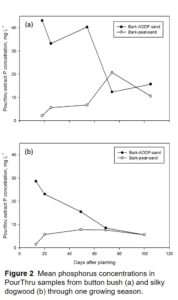
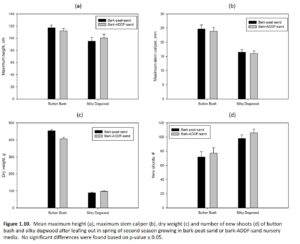
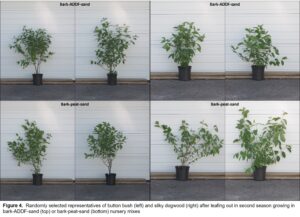
There were no significant differences in initial physical properties (Table 1) or pH (5.53 for bark-peat-sand and 5.66 for bark-ADDF-sand) between the mixes. The bark-ADDF-sand mix had a higher mean EC (1230µS vs. 156µS). At the beginning of the second growing season the bark-ADDF-sand mix had significantly lower EWHC and CCAP than the bark-peat-sand mix. Both mixes did, however, have similar Db upon final measure (Table 2). The bark-peat-sand mix had significantly more shrinkage in the first season under drip irrigation whereas the bark-ADDF media had significantly more shrinkage upon final measure after approximately 10 weeks of overhead irrigation. Both mixes had the same total amount of shrinkage.
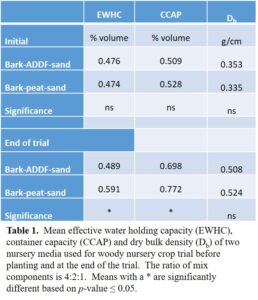
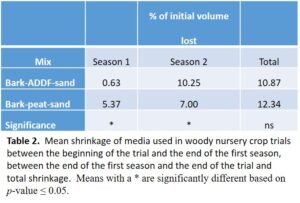
Woody Cuttings. At the end of the first growing season there were no noticeable differences between plants in the two mixes. At the beginning of the second season both ninebark and viburnum grown in the bark-ADDF-sand mix appeared to break from dormancy more quickly, vigorously and with darker foliage than those grown in the bark-peat-sand mix (Fig. 5). The plants grown in the bark-ADDF-sand mix were also significantly taller than the plants grown in bark-peat-sand mix. Ninebark grown in the bark-ADDF-mix had a greater dry weight but there was no difference in dry weight between viburnum grown in either mix (Fig. 6).
.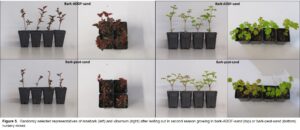
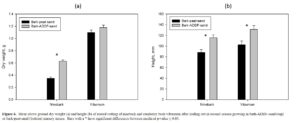
Herbaceous Nursery Crops. Of all plant growth parameters measured, the only significant differences between plants grown in bark-peat-perlite and bark-ADDF-perlite were greater fresh and dry weights in Shasta daisy grown in the bark-ADDf-perlite mix (Tables 3-7). While no differences were found in measured parameters there were some visible differences in plant growth and development between the two treatments in some species (Fig 7). Coreopsis (Fig 7b) grown in the bark-ADDF-perlite mix was slightly chlorotic and less dense. Brunnera (Fig. 7a) grown in the bark-ADDF-perlite mix had slightly chlorotic leaf margins and a deeper blue flower color than those grown in the bark-peat-perlite mix. Overall, plants growth in the bark-ADDF-perlite mix were more variable than in the control mix with many plants in the bark-ADDF-perlite mix being of higher quality and larger size than those grown in the bark-peat-perlite but others being severely stunted.
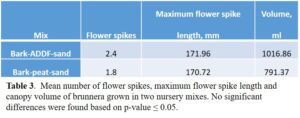
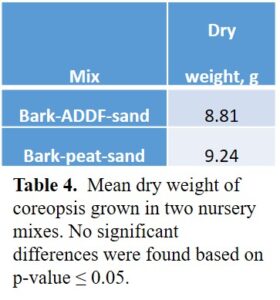
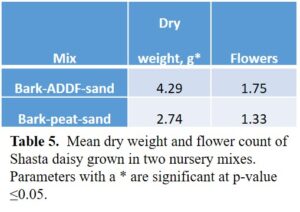
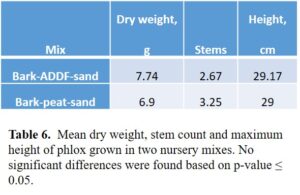
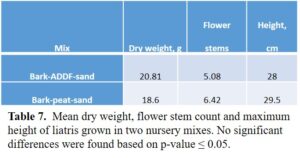
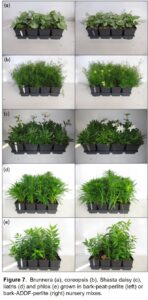
A much greater amount of phosphate was leached from pots containing the bark-ADDF-perlite mix and continued to be released through the growing season of all crops tested (Fig. 8)
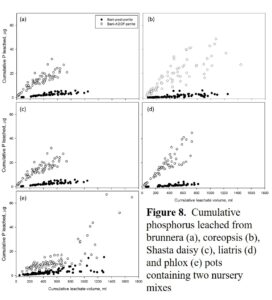
In the unplanted pot leaching, phosphate was continually released from the raw ADDF and the bark-ADDF-perlite mix throughout the trial and only began to plateau at the end. Peat and the bark-peat-perlite mix released negligible amounts of phosphate (Fig 9).
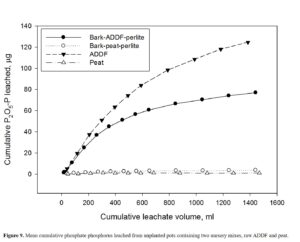
Virtually all nitrate was released after the fourth leaching event. The raw ADDF released far more nitrate than the bark-ADDF-perlite. The bark-ADDF-perlite mix is slightly less than 30% ADDF but only releases approximately 17% of the nitrate released from the raw ADDF. This suggests that mixing ADDF with bark immobilizes nitrogen and reduces nitrate leaching. Peat and the bark-peat-perlite mix released negligible amounts of nitrate (Fig 10).
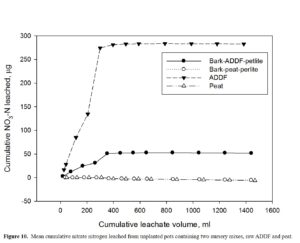
Ammonium was slowly released by all mixes with the ADDF mixes releasing the greatest quantities (Fig 11).
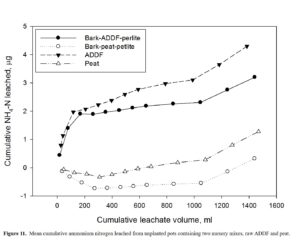
There was an initial dip in pH followed by a rise and a leveling off (Fig 12). Most soluble salts were leached in the first few leaching events (Fig 13). The rapid release of nitrate and soluble salts in ADDF paired with the steady release of phosphate suggest ADDF has a large store of adsorbed labile phosphate 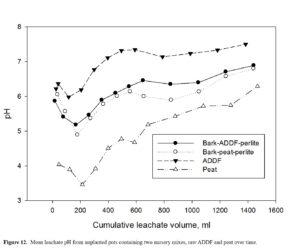
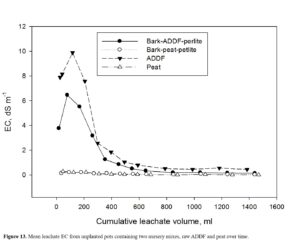
Discussion
ADDF can be used as a partial replacement for peat in nursery mixes. Irrigation, fertilization and pH management must be considered carefully when using an ADDF as a media component.
Amending ADDF-containing mixes with gypsum was effective in supplying plants with Ca while not affecting the pH. A magnesium source should be added to the fertilization regime of ADDF-containing mixes in an appropriate ratio with gypsum to supply the required amount and ratio of Ca and Mg without greatly altering the pH.
Results from all these trials show that ADDF is a significant source of plant available phosphorus. There were higher concentrations of P in leachate and PourThru samples from ADDF-containing mixes throughout the growing cycles of all trials. The continued release of P may be from the dissolution of calcium phosphate minerals, which are often found in dairy manure and dissolve at pH below 7 (Shober et al., 2010). Measures should be taken to limit P leaching from ADDF-containing mixes, such as using irrigation systems with little or no leaching, adjusting to low P fertilization regimes or formulating media with pH closer to neutral to slow dissolution of calcium phosphate minerals. Certain media amendments, such as dried alum sludge have been shown to greatly reduce P leaching from media containing organic P sources without adversely affecting plant growth (Bugbee & Elliott, 1999).
Shober et al. (2011) reported that leachate from CowPeat contained only negligible amounts of reactive nitrogen, often even less than peat based mixes. The leaching trials conducted for this research showed much greater quantities of reactive nitrogen being leached from ADDF- containing mixes than from mixes without ADDF. The differences in the nitrogen leaching between Shober et al. (2011) and this research could be due to regional differences in dairy manure (Florida vs Connecticut) or in differences between how aerobic (CowPeat) and anaerobic (ADDF) processing of dairy manure affects the nitrogen forms in the processed material. Nitrogen leaching was not a concern in the use of CowPeat but may be for the use of ADDF. When using ADDF, growers should adopt practices to minimize nutrient leaching, such as adjusting fertilizer rates, minimizing leachate volume or using a recirculating irrigation systems.
In the nursery mixes peat made up a much smaller proportion of the mix than in greenhouse mixes (slightly less than 30% vs. 80%) used in some previous trials. ADDF was an acceptable replacement for all the peat in the mix rather than only replacing 50% of the peat as in greenhouse mixes previously tested. All crops grown in ADDF-containing mixes grew to a similar or better size and quality than those grown in the peat-based mixes. This may have been due to the smaller proportion of peat being replaced or that nursery crops are generally more robust than greenhouse and floriculture crops and may be better able to tollerate a wider range of root zone conditions. Despite the smaller proportion of peat in nursery mixes, nursery crops are grown in containers with much larger volumes, which require greater volumes of media than greenhouse crops so using ADDF as a replacement for peat in nursery mixes could still significantly reduce demand for peat.
While the growth and quality of plants grown in ADDF containing mixes were statistically similar to those grown in the peat-based control mixes, growth responses of plants in the ADDF mix were generally more variable. It is important for a growing mix to produce consistent results so, while the ADDF mixes yielded acceptable means, the variable growth in some species may be unacceptable in commercial applications. This variability may have been due to management decisions or the ADDF itself.
In these trials, management decisions were based on established cultural recommendations for peat-based control mixes. In many cases, irrigation management that was optimal for the control mix was less than optimal for other treatments. This was illustrated by the media analyses at before, during and after the woody nursery crop trial. The ADDF mix had less shrinkage than the control during the first season when pots were under drip irrigation but experienced much more shrinkage during the second season under overhead irrigation. Many of the crops that were exclusively overhead irrigated, like phlox, coreopsis and cranberry bush viburnum had dead or severely stunted individuals. All of this suggests overhead irrigation may lead to accelerated compaction of ADDF mixes. Better results may be produced with individualized management decisions based on differences in mixes. Additionally, ADDF is a significant source of phosphate and nitrate so fertilization regimes should be adjusted accordingly.
Some of the variability in growth response of plants grown in ADDF-containing mixes may have been due to heterogeny of the ADDF itself. The ADDF used in this project was processed to be used in the production of biodegradable “Cowpots™” rather than for use in potting media. It may be possible to produce an ADDF product that yields more consistent results if it is specifically processed to be used media component as is done with other anaerobically digested organic media components such as Magic DirtTM or EcoTek®.
There may also be variability in ADDF on a larger scale. Dairy feed can vary from region to region and seasonally so the feedstock used to produce ADDF likely varies equally. Climatic differences have been shown to influence the nutrient availability in manure. Growing degree days have been shown to be useful in predicting nitrogen availability from manure (Griffin and Honeycutt, 2000). Regional variability in dairy manure may have contributed to discrepancies between the results of this research and the results of research using a dairy manure product in Florida (Shober et al., 2011). However, similarities in results of chemical and physical analysis of ADDF and ADDF-containing mixes between MacConnell and Collins (2007) in Washington and these trials in Connecticut demonstrate that ADDF can be consistent from region to region. Special consideration must be given to any potential variability in ADDF.
As with other alternative media components more research is needed to establish the best ways to manage ADDF in media and to process ADDF into a consistent horticultural material. Apart from establishing best practices for ADDF, it is an acceptable replacement for peat in for a diversity of nursery crops.
References
Bugbee, G.J. and G.C. Elliott. 1999. Effects of sucrose and dried alum sludge on the growth of rudbeckia and leaching of nitrogen and phosphorus from potting media containing biosolids compost. Bull. Environ. Contam. Toxicol. 63:766-773.
Griffin, T.S. and C.W. Honeycutt. 2000. Using growing degree days to predict nitrogen availability from livestock manure. Soil Sci. Soc. Amer. Jour. 64(5):1876-1882.
MacConnell, C.B. and H.P. Collins. 2007. Utilization of re-processed anaerobically digested fiber from dairy manure as a container media substrate. Proc. IS on Growing Media.
Shober, A.L., C. Wiese, G.C. Denny, C.D. Stanley and B.K. Harbaugh. 2010. Plant performance and nutrient losses during containerized bedding plant production using composted dairy manure solids as a peat substiture in substrate. HortScience, 45(10):1516-1521.
Shober, A.L., C. Wiese, G.C. Denny, C.D. Stanley and B.K. Harbaugh. 2011. Plant performance and nutrient losses during containerized landscape shurb production using composted dairy manure solids as a peat substiture in substrate. HortTechnology, 21(2):240-245.
The results of this project show that ADDF can be used as a 1:1 replacement for peat in nursery mixes. ADDF can be used as a renewable, locally sourced media component for nursery growers of the Northeast. Adoption of ADDF in nursery mixes in the Northeast would decrease the demand for peat and reduce the environmental impact of peat harvest and transport. ADDF will likely be less expensive than peat because it is currently a waste management liability for dairy farmers. Additional nutrients provided from ADDF could also decrease fertilizer requirement for crops grown in ADDF mixes.
ADDF can also generate additional income for dairy farmers with anaerobic digesters as a high quality horticultural product. Adding value to ADDF will further incentivize more dairy farmers to adopt anaerobic digestion systems for waste management.
Education & Outreach Activities and Participation Summary
Participation Summary:
A manuscript based on this project was published in the February 2016 edition of The American Journal of Plant Sciences.
Several articles based on the results of this project were published in trade journals aimed at a wide range of audiences. “Anaerobically digested dairy fiber: A Renewable Substitute for Peat” appeared in the September 2015 issue of Greenhouse Product News and will reach members of the greenhouse and floriculture industry. “Alternatives to Peat” was published in the October 2015 edition of Permaculture whose audience is composed of small scale growers and home gardeners interested in sustainable agriculture. The potential of ADDF as a horticultural product was communicated to the dairy industry via “Anaerobically Digested Dairy Fiber: A Valuable Product” in the November 2015 edition of Progressive Dairyman. “Unconventional Components” appeared in the December 2015 issue of Nursery Management and communicated the results of this project with the nursery industry. Another article is scheduled to appear in Acres USA, a sustainable agriculture magazine, in early 2016.
Results from this project were presented at The 2015 Northeast Region of the American Society for Horticulture Sciences meeting at The University of Deleware (ADDF Poster Final)
Project Outcomes
Farmer Adoption
Numerous growers were contacted in the summer of 2014 to see if they would be interested in trying an ADDF containing mix. Most growers did not respond but some asked to check back in the winter when things were not so busy. I checked back with growers in early January and Summer Hill Nursery expressed interest in the new mix. George Elliott and I met with the grower and delivered a small amount of ADDF to run small trials with in mid-January. The winter of 2015 was very cold and continued far into the spring, delaying crops by weeks so the grower at Summer Hill did not have an opportunity to run any tests with the sample delivered in January. The grower would not be able to run any preliminary trials until August.
Areas needing additional study
Management decisions for these trials were based on best practices for the peat-based control. The ADDF-containing mixes produced acceptable results but may better results may be obtainable if practices tailored to ADDF mixes are developed. Best irrigation and nutritional management practices for ADDF mixes should be established to optimize plant growth results. Nutrient leaching from ADDF mixes may pose an environmental issue. Ways to limit nutrient leaching from ADDF mixes should be investigated.
Many alternative media components are processed to have specific properties and fill specific roles in a mix. For example, parboiled rice hulls can be milled to different sized particles to replace either peat or perlite. The best ways to process ADDF for use in potting mixes should be investigated.
There should be few regional differences in ADDF within the Northeast but different ADDF from different dairy operations should be surveyed to determine if there are any differences in ADDF between anaerobic digesters.